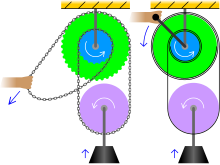Windlass
- For the tool used to raise paddle gear on canal locks, see Windlass ("lock key")


The windlass is an apparatus for moving heavy weights. Typically, a windlass consists of a horizontal cylinder (barrel), which is rotated by the turn of a crank or belt. A winch is affixed to one or both ends, and a cable or rope is wound around the winch, pulling a weight attached to the opposite end. The oldest depiction of a windlass for raising water can be found in the Book of Agriculture published in 1313 by the Chinese official Wang Zhen of the Yuan Dynasty (fl. 1290–1333).[1]
Uses
- Vitruvius, a military engineer writing about 28 B.C., defined a machine as "a combination of timber fastened together, chiefly efficacious in moving great weights." About a century later, Hero of Alexandria summarized the practice of his day by naming the "five simple machines" for "moving a given weight by a given force" as the lever, windlass, screw for power, wedge, and tackle block (pulley). Until nearly the end of the nineteenth century it was held that these "five mechanical powers" were the building blocks from which all more complex assemblages were constructed.' [2]
- During the Middle Ages the windlass was used to raise materials for the construction of buildings such as in Chesterfield's crooked spire church.[3]
- By the Late Middle Ages most European crossbows employed a windlass as a cocking mechanism, which helped to pull heavier crossbows, but were used in England as early as 1215.[4]
- Windlasses are sometimes used on boats to raise the anchor as an alternative to a vertical capstan (see anchor windlass).
- The rod or stick used to tighten a tourniquet in surgical procedures is called a windlass.
- The handle used to open locks on the UK's inland waterways is called a windlass.
- Windlass can be used to raise water from a well. The oldest description of a well windlass, a rotating wooden rod installed across the mouth of a well, is found in Isidore of Seville's (c. 560–636) Origenes (XX, 15, 1-3).[5]
- Windlass have also been used in gold mining. A windlass would be constructed above a shaft which allowed heavy buckets to be hauled up to the surface.[6] This process would be used until the shaft got below 40 metres deep when the windlass would be replaced by a 'whip' or a 'whim'.[7]
Differential windlass

In a differential windlass, also called a Chinese windlass,[8][9][10] there are two coaxial drums of different radii r and r'. The rope is wound onto one drum while it unwinds from the other, with a movable pulley hanging in the bight between the drums. Since each turn of the crank raises the pulley and attached weight by only , very large mechanical advantages can be obtained.
See also
References
- ^ Needham, Joseph (1986), Science and Civilization in China: Volume 4, Physics and Physical Technology, Part 2, Mechanical Engineering. Taipei: Caves Books, Ltd.
- ^ "Kinematic Synthesis of linkages".
- ^ "Medieval Builders' Windlass". http://www.bbc.co.uk. Retrieved September 11, 2012.
{{cite web}}: External link in|publisher= - ^ "Engineering the Medieval Achievement-The Crossbow". http://web.mit.edu. Retrieved September 11, 2012.
{{cite web}}: External link in|publisher= - ^ Oleson, John Peter (1984), Greek and Roman Mechanical Water-lifting Devices. The History of a Technology, Dordrecht: D. Reidel, pp. 56f., ISBN 90-277-1693-5
- ^ "Albert Goldfields Mining Heritage" (PDF). http://outbacknsw.com.au. Retrieved September 11, 2012.
{{cite web}}: External link in|publisher= - ^ "Searching for Gold". http://www.kidcyber.com.au. Retrieved September 11, 2012.
{{cite web}}: External link in|publisher= - ^ "Chinese". Oxford English Dictionary (Online ed.). Oxford University Press. (Subscription or participating institution membership required.) (registration required)
- ^ Morris, Christopher, ed. (1992), Academic Press Dictionary of Science and Technology, Gulf Professional Publishing, p. 416, ISBN 978-0-12-200400-1
- ^ Knight, Edward H. (1884), The Practical Dictionary of Mechanics, Cassell, Petter, Galpin & Co "Chinese-windlass, a differential windlass in which the cord winds off one part of the barrel and on to the other."

